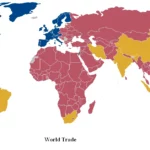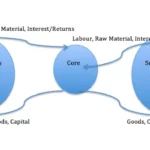Hey there, world traveler! Getting ready to conquer AP Human Geography? Excellent choice! Let’s unpack a key concept you’ll encounter: semi-peripheral economies. These aren’t your straightforward “rich” or “poor” countries – they’re the fascinating “in-betweeners” of the world stage. Get ready to explore their unique ups and downs, the forces of urbanization and globalization shaping their trajectories, and what it all means for the people who call these places home.
Semi-Periphery AP Human Geography: The Intriguing Middle Ground
In AP Human Geography, the term “semi-periphery” might sound a tad technical at first, but trust us, it’s way more interesting than you might think! Think of it as a spectrum of global economic development.
- Core Countries: At one end, you have the heavy hitters like the United States, Japan, and Germany. They’re the economic powerhouses, technologically advanced, and wielding significant global influence.
- Periphery Countries: On the other end, you’ll find countries often still in the developing stages, facing challenges like poverty, limited infrastructure, and a heavy reliance on agriculture.
- Semi-Periphery Countries: Nestled between these two is the semi-periphery. They exhibit a compelling blend of core and periphery characteristics, making them a crucial part of the global economic tapestry.
What Defines a Semi-Peripheral Country?
While there’s no official checklist, here are some telltale signs:
- Urban-Rural Divide: Imagine stepping off a plane in a semi-peripheral country. You might find yourself in a bustling city with modern skyscrapers, a booming tech scene, and all the conveniences of a developed nation. But venture beyond the city limits, and you’ll likely encounter rural areas grappling with poverty, limited access to education and healthcare, and a stark contrast in infrastructure.
- The Intermediaries of Global Trade: Semi-peripheral countries often serve as vital links between the core and periphery. They play a critical role in facilitating trade, manufacturing goods, and even spreading technology. They keep the global economic engine humming, acting as a bridge between the two extremes.
Why Should You Care?
You might be wondering why this matters for your AP exam. Well, understanding the semi-periphery is key to grasping several big-picture concepts:
- Nuances of Global Development: The existence of semi-peripheral economies challenges the simplistic notion that development is a linear path from “poor” to “rich.” It highlights the complexities of global economic relationships and the interconnectedness of nations.
- Shifting Power Dynamics: Semi-peripheral countries can become hotspots for geopolitical maneuvering. They might be courted by core countries seeking alliances, resources, or strategic partnerships. Observing these dynamics can provide valuable insights into the shifting balance of global power.
- Potential and Challenges of Growth: The semi-periphery is brimming with potential. These countries have the opportunity to leverage their unique position to drive economic growth, diversify their industries, and potentially ascend to core status. However, they also face the constant challenge of balancing economic progress with social equality. Addressing issues like poverty, income inequality, and access to education and healthcare within their borders is crucial for their long-term stability and prosperity.
Research and Evolving Perspectives:
The study of the semi-periphery is an ongoing process, with researchers constantly refining their understanding. Some experts suggest that globalization is blurring the lines between core, periphery, and semi-periphery. The increasing interconnectedness of economies, the rise of digital technologies, and the shifting balance of global power dynamics all contribute to this complexity.
Examples of Semi-Periphery Countries
Let’s delve into some real-world examples to solidify our understanding:
What is an example of periphery in AP Human Geography?
A prime example of a periphery country is Bangladesh. While rich in culture and possessing a large population, Bangladesh faces significant development challenges:
- Income Disparities: A substantial portion of the population lives below the poverty line, with limited access to basic necessities.
- Industrial Development: Bangladesh’s economy relies heavily on agriculture, and industrialization has been relatively slow, limiting its ability to compete globally in diverse sectors.
- Education and Technology: Limited access to quality education and technological resources poses a barrier to achieving widespread economic growth and social mobility.
- Vulnerability to Natural Disasters: Situated in a geographically vulnerable region, Bangladesh frequently experiences cyclones and floods, which can devastate infrastructure and impede progress.
It’s important to note that being classified as a periphery country doesn’t imply a permanent state. Bangladesh has made commendable strides in areas like poverty reduction and education, indicating its potential for positive change.
What are 5 semi-periphery countries?
Here are five countries commonly categorized as semi-peripheral:
- Brazil: Brazil boasts a diverse economy, being a major player in agriculture, mining, and manufacturing. However, issues like poverty, income inequality, and political instability persist, hindering its overall development trajectory.
- India: India has emerged as a technological powerhouse, particularly in software development and IT services. However, it grapples with vast socioeconomic disparities, a large rural population facing poverty, and inadequate infrastructure in many regions.
- South Africa: Endowed with abundant natural resources, South Africa has a relatively developed industrial sector. However, legacies of apartheid continue to cast a long shadow, contributing to high levels of inequality and social unrest.
- Mexico: With a strong manufacturing base, particularly in the automotive industry, Mexico has close economic ties to the United States. However, challenges like poverty, crime, and corruption persist, hindering its progress.
- China: China’s economic transformation over the past few decades has been nothing short of remarkable. While often considered a rising global power, China still exhibits significant internal disparities between its prosperous urban centers and its vast rural hinterland. Its classification as semi-periphery is frequently debated, as it increasingly displays characteristics associated with core countries.
Remember, these classifications are not static. Globalization, technological advancements, and geopolitical shifts can influence a country’s economic trajectory, potentially leading to reclassification over time.
What is an example of periphery and semi-periphery?
To illustrate the distinction, let’s consider these examples:
- Periphery: Nepal, located in South Asia, serves as a prime example of a periphery country. Its economy is heavily reliant on agriculture, with limited industrial development. Poverty is widespread, access to education and healthcare is limited, and the country faces significant infrastructure challenges.
- Semi-Periphery: South Korea presents a compelling case of a semi-periphery nation. In the latter half of the 20th century, South Korea underwent rapid industrialization and economic growth, transforming itself from a largely agrarian society to a global leader in technology and manufacturing. While it has achieved a high level of development, South Korea still exhibits some characteristics of a semi-peripheral economy, including its dependence on exports and its vulnerability to global economic fluctuations.
Understanding the Core-Periphery Model
To fully grasp the concept of semi-periphery, it’s essential to understand the broader framework within which it exists: the Core-Periphery Model.
What is core-periphery in human geography?
Imagine the global economy as a interconnected system, with countries occupying different positions based on their level of development, influence, and economic power. The Core-Periphery Model provides a way to visualize these relationships:
- Core: These are the economic powerhouses – the “center” of the global system. Think of countries like the United States, Japan, Germany, and the United Kingdom. They are characterized by:
- High levels of industrialization and technological advancement
- Dominance in global trade and finance
- High standards of living and access to education and healthcare
- Significant political and cultural influence
- Periphery: These countries occupy the “outer edges” of the global system and are often characterized by:
- Dependence on core countries for trade, investment, and technology
- Lower levels of industrialization and technological development
- Lower standards of living and limited access to education and healthcare
- Vulnerability to economic exploitation and political marginalization
- Semi-Periphery: Positioned between the core and periphery, these countries exhibit a mix of characteristics:
- Experiencing industrialization and economic growth, but not at the level of core countries
- Often serving as manufacturing hubs for goods consumed in core markets
- May have a growing middle class but still face significant income inequality
- Often seeking to increase their global influence and move closer to core status
This model helps us understand how global economic relationships can create and perpetuate inequalities between countries.
Importance of the Core-Periphery Model
While the Core-Periphery Model provides a useful framework, it’s essential to recognize that the global economy is complex and constantly evolving:
- Fluid Boundaries: The lines between core, periphery, and semi-periphery are not fixed. As countries develop, their position within the global economy can change.
- Internal Variations: Even within core, periphery, or semi-periphery countries, significant regional variations in development and wealth can exist.
What is the Peripheral Model AP Human Geography?
The Peripheral Model in AP Human Geography focuses specifically on urban development patterns. It describes how cities grow outward from a central business district (CBD), with different zones developing at varying distances from the core:
- Central Business District (CBD): The heart of the city, characterized by high-density commercial land use, skyscrapers, and a concentration of economic activity.
- Residential Zones: As you move away from the CBD, you’ll find residential areas that vary in density and housing types, from high-density apartments to single-family homes in the suburbs.
- Industrial and Manufacturing Zones: These areas are often located on the outskirts of the city, where land is cheaper and there’s more space for factories and warehouses.
- Edge Cities: Over time, as cities grow, suburban areas can develop their own commercial centers and employment hubs, becoming less dependent on the central city.
The Peripheral Model helps explain urban sprawl, the process of cities expanding outward, often at the expense of surrounding rural areas.
Conclusion: Navigating the Complexities of Semi-Periphery
Understanding the concept of semi-periphery is crucial for grasping the complexities of the global economy and the challenges and opportunities facing countries in this category. By studying their unique characteristics, their relationships with core and periphery nations, and the forces of globalization and technological change, we can gain a deeper understanding of the evolving dynamics of our interconnected world.
- Discover Long Black Pepper: Flavor & Health Benefits - April 25, 2025
- Shocking Twists: The Grownup Review: Unreliable Narration - April 25, 2025
- A Quiet Place Book vs Movie: A Deep Dive - April 25, 2025
















